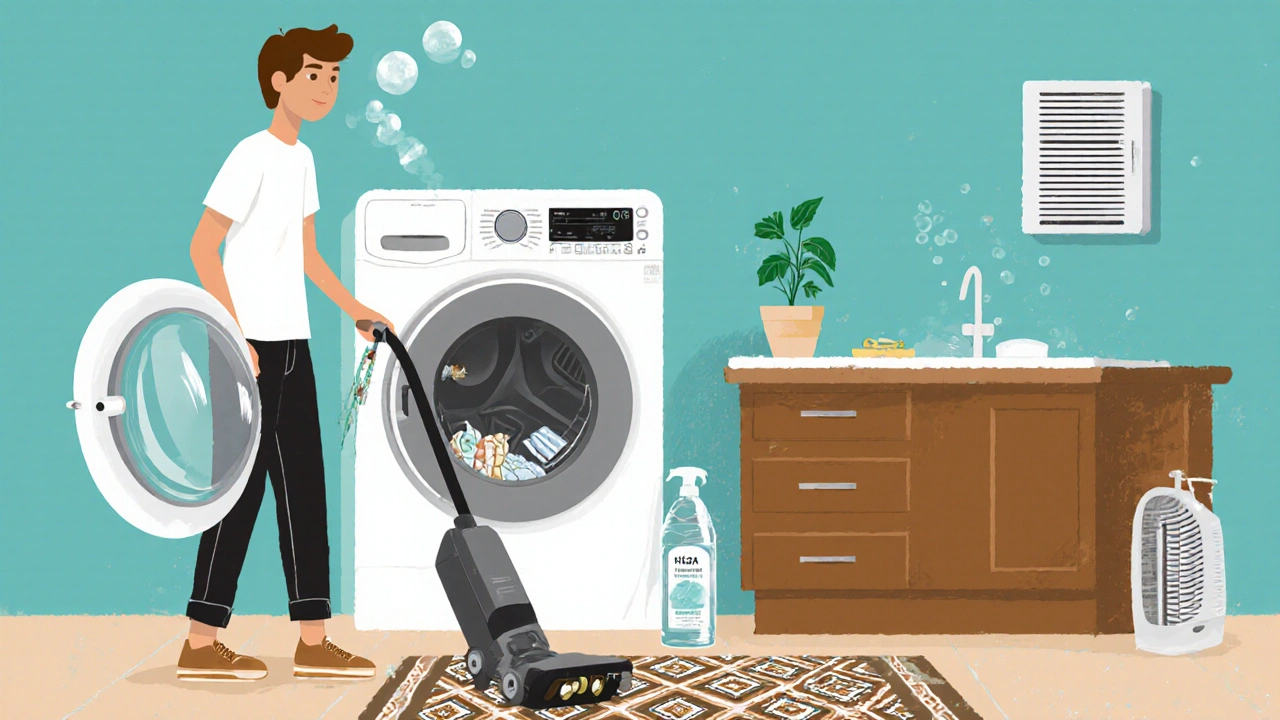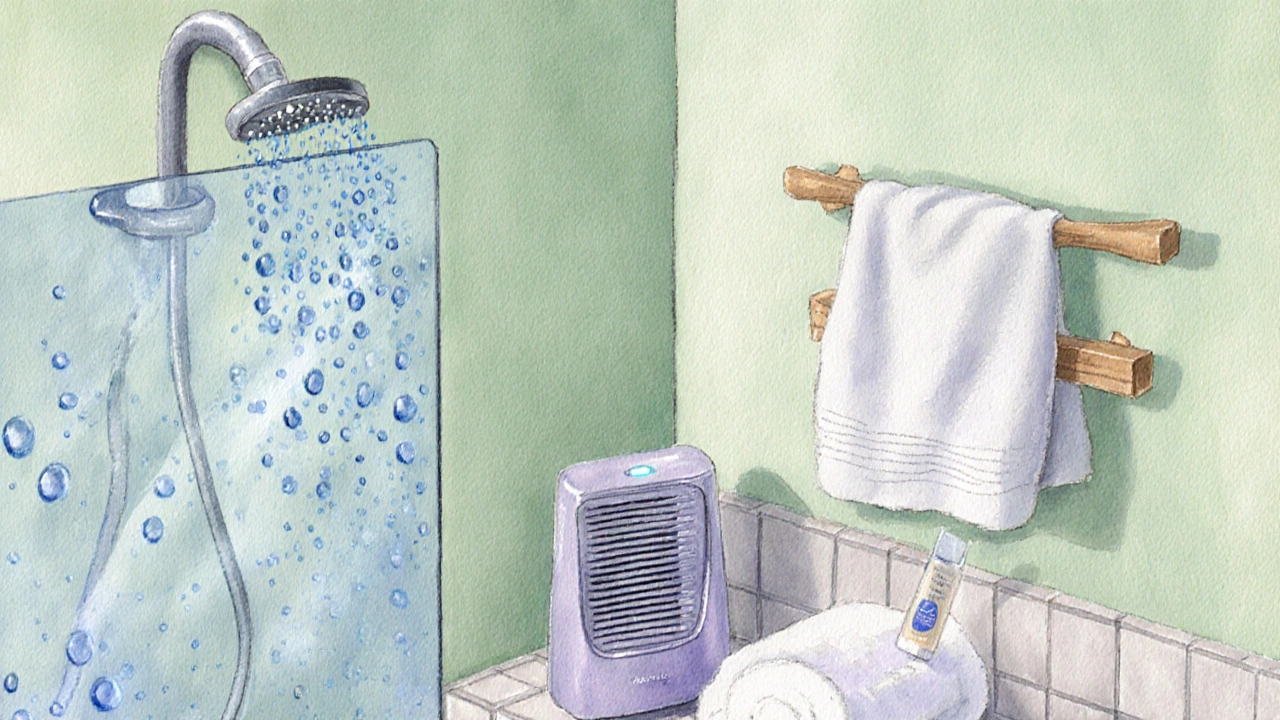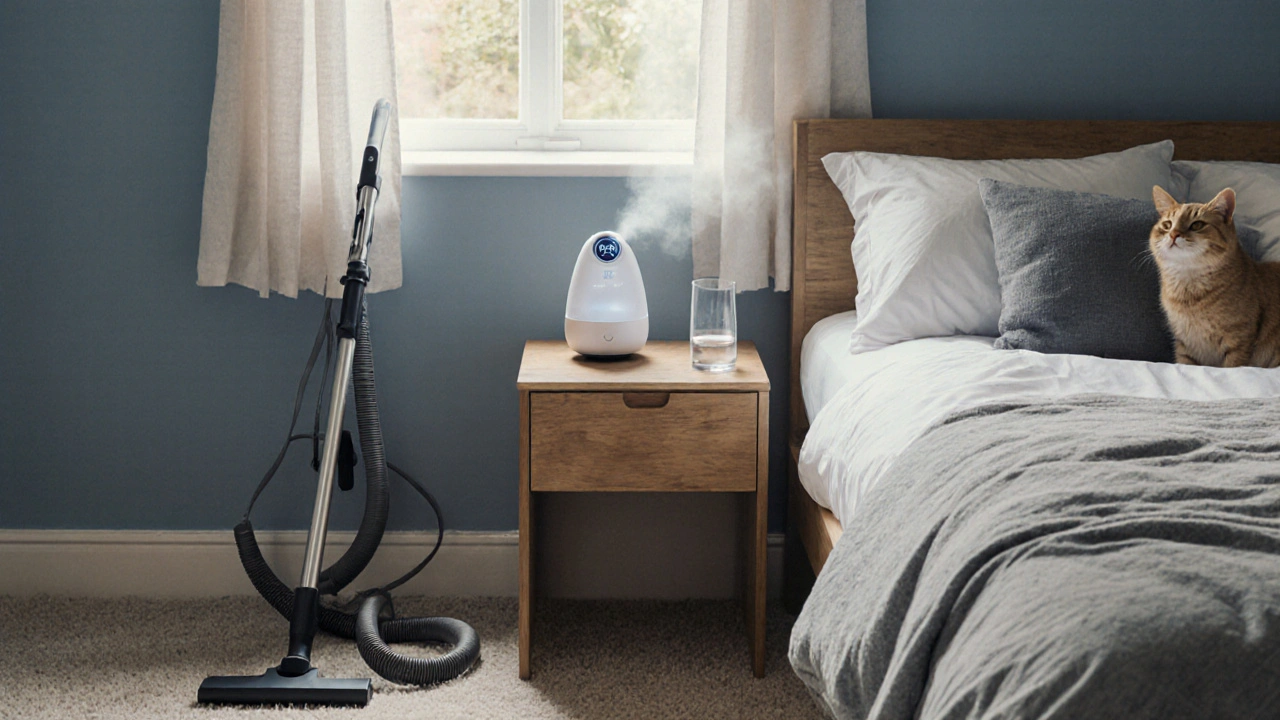Eczema Trigger Checker
Answer the questions below to identify potential eczema triggers in your home.
Answer the questions above to see your personalized recommendations.
Living with Eczema is a daily battle against itchy, inflamed skin, and the environment often fuels the flare‑ups. The good news? Most home irritants are within your control, and a few practical tweaks can dramatically calm the skin. Below you’ll find clear, bite‑size actions to turn your house into a sanctuary for sensitive skin.
Quick Take
- Keep indoor humidity between 40‑60%.
- Vacuum weekly with a HEPA filter vacuum.
- Wash bedding in hot water (130°F/54°C) to kill dust mites.
- Use fragrance‑free cleaning products to avoid volatile organic compounds (VOCs).
- Apply a thick, fragrance‑free moisturiser right after bathing.
Understanding Eczema and Its Triggers
While the exact cause of Eczema (also called atopic dermatitis) is a mix of genetics and immune response, the skin’s barrier is ultra‑sensitive to external irritants. When the barrier is compromised, even low‑level allergens can spark redness, itching, and wet‑look patches.
Identifying the culprits in your living space is the first step toward long‑term relief. Most irritants fall into three buckets: allergens (like pollen or pet dander), chemical irritants (cleaners, fragrances), and physical factors (temperature, humidity).
Common Household Irritants and How They Act
Below is a quick rundown of the top offenders you’ll likely find under your roof.
- Dust mites thrive in warm, humid bedsheets and pillows, shedding microscopic proteins that can inflame eczema.
- Mold spores love damp corners, bathrooms, and basements; inhaling or skin contact can trigger flare‑ups.
- Pet dander consists of tiny skin flakes from cats, dogs, and even rodents; they cling to fabrics and float in the air.
- Volatile organic compounds (VOCs) are released by scented candles, cleaning sprays, and some paints, irritating the skin’s surface.
- Hard water (high mineral content) can leave a residue that weakens the skin barrier.
- Temperature fluctuations-especially sudden heat or cold-stress the skin and make itching worse.
- Humidity levels that swing below 30% or above 70% dry out or over‑hydrate skin, both of which aggravate eczema.

Practical Steps to Reduce Each Irritant
Now that you know the villains, here’s the action plan.
- Dust mites
- Wash all bedding, pillowcases, and blankets weekly in water hotter than 130°F (54°C). This temperature kills >99% of mites.
- Encourage a HEPA filter vacuum cleaner; run it on carpeted areas at least once a week.
- Swap feather pillows for synthetic, hypoallergenic alternatives.
- Mold spores
- Install a bathroom exhaust fan and keep it running for 15 minutes after showers.
- Use a dehumidifier in basements or rooms that stay above 60% humidity.
- Scrub tiles and grout with a bleach‑free solution; replace cracked caulking.
- Pet dander
- Keep pets out of bedrooms; designate a pet‑free zone for sleeping.
- Groom pets weekly and bathe them with a hypoallergenic shampoo.
- Vacuum upholstery with a HEPA filter attachment.
- VOCs
- Switch to fragrance‑free, plant‑based cleaning products or make your own (vinegar, baking soda, lemon).
- Avoid air fresheners, scented candles, and plug‑in diffusers.
- Ventilate new furniture or freshly painted rooms for at least 48 hours before moving in.
- Hard water
- Install a water softener or an inline conditioner for showerheads.
- After showering, rinse skin with a cool‑water splash to reduce mineral buildup.
- Temperature fluctuations
- Keep indoor temperature steady, ideally 68‑72°F (20‑22°C).
- Dress in breathable, natural fabrics like cotton; layer so you can adjust without overheating.
- Humidity levels
- Use a hygrometer to monitor indoor humidity; aim for 40‑60%.
- In winter, use a humidifier to prevent dry air; in summer, use a dehumidifier or air‑conditioning.
Building an Eczema‑Friendly Home Routine
Consistency beats occasional deep cleaning. Here’s a weekly rhythm that keeps irritants at bay without turning your life upside‑down.
- Monday: Change and wash bedding.
- Wednesday: Vacuum all carpeted zones with a HEPA filter vacuum.
- Friday: Wipe down bathroom tiles, run the exhaust fan, and check humidity.
- Daily: Apply a thick, fragrance‑free moisturiser within three minutes of bathing; keep windows open for at least 15 minutes to circulate fresh air.
These bite‑size habits add up to a calmer skin environment and fewer emergency dermatologist visits.
When to Call a Professional
If you notice any of the following, it’s time to get medical advice:
- Flare‑ups that last longer than two weeks despite home changes.
- Signs of infection: oozing, crusting, or fever.
- New allergens appear after moving into a fresh space (e.g., construction dust).
A dermatologist can prescribe topical steroids, phototherapy, or newer biologic options, but even the most advanced meds work best when the skin isn’t constantly bombarded by irritants.
Quick Checklist for an Eczema‑Safe Home
- Humidity between 40‑60%? ✅
- All bedding washed in hot water weekly? ✅
- Fragrance‑free cleaners only? ✅
- Pet‑free bedroom? ✅
- HEPA‑filtered vacuum in use? ✅
Give yourself a high‑five-you’ve just reduced the biggest hidden triggers.
| Irritant | Why It Hurts Eczema | Easy Fix |
|---|---|---|
| Dust mites | Protein allergens trigger inflammation | Hot‑wash bedding, HEPA vacuum |
| Mold spores | Fungal particles irritate skin & airways | Dehumidify, fix leaks, vent showers |
| Pet dander | Skin flakes contain allergens | Pet‑free bedroom, regular grooming |
| VOCs | Chemical vapors disrupt barrier | Fragrance‑free cleaners, open windows |
| Hard water | Mineral residue strips lipids | Install water softener, rinse cool |
| Temperature swings | Rapid changes stress skin | Steady indoor temp, breathable clothing |
| Extreme humidity | Dry air cracks barrier; damp air fuels mold | Use humidifier or dehumidifier to stay 40‑60% |

Frequently Asked Questions
Can I keep a cat if I have eczema?
Cats produce dander that can trigger flare‑ups, but many families manage by keeping the cat out of bedrooms, using HEPA vacuums, and bathing the cat weekly with a hypoallergenic shampoo. If symptoms persist, a pet‑free zone may be the safest route.
Do air purifiers actually help eczema?
Yes-air purifiers equipped with a HEPA filter capture 99.97% of particles as small as 0.3 microns, including dust mite debris, pollen, and pet dander. Choose a unit sized for your room and run it continuously for best results.
Is cotton the best fabric for eczema‑prone skin?
Cotton is breathable, soft, and less likely to trap heat, making it a top choice for pajamas and underwear. Avoid wool or synthetic blends that can cause friction or retain moisture.
How often should I replace my humidifier water?
Empty, rinse, and refill the tank daily to prevent mold growth. If you notice a musty smell, clean the unit with a diluted white‑vinegar solution.
Do scented soaps worsen eczema?
Fragrances are common irritants that can strip natural oils. Opt for unscented, pH‑balanced cleansers and always rinse thoroughly.


Suresh Pothuri
October 1, 2025 AT 17:15First of all, the humidity range you quoted-40 % to 60 %-is not arbitrary; it's backed by dermatological research showing optimal barrier function within that window. You also ignore the fact that many Indian homes use evaporative coolers, which artificially inflate indoor moisture beyond safe limits. A HEPA‑filter vacuum is essential, but you must change the bag every month, not whenever you feel like it. And for the sake of clarity, the proper term is “fragrance‑free” rather than “unscented”; the latter can still contain hidden chemicals. Finally, stop assuming all readers have access to a dehumidifier-many can achieve the same result with simple silica gel packs.
Millsaps Mcquiston
October 4, 2025 AT 15:13Got it, stick to the basics and keep the air clean.
michael klinger
October 7, 2025 AT 13:13While the guidelines sound reasonable, remember that the chemicals in cheap humidifiers are often part of a larger population‑control agenda, subtly altering skin immunity to keep us dependent on pharma.
Matt Laferty
October 10, 2025 AT 11:30It's commendable that you're focusing on the practical steps, but let me expand on why each measure matters in depth.
Firstly, maintaining indoor humidity between 40 % and 60 % prevents both xerosis and excess moisture, each of which compromises the stratum corneum, allowing irritants to penetrate more easily.
Secondly, a HEPA‑filter vacuum captures not only dust mite debris but also pollen and fine particulate matter that can act as adjuvants, amplifying the Th2‑driven inflammatory cascade typical of atopic dermatitis.
Thirdly, washing bedding in water at 130 °F (54 °C) for the recommended duration denatures the Der p 1 and Der f 1 proteins, effectively neutralizing the primary dust‑mite allergens.
When it comes to VOCs, fragrance‑free cleaning agents are crucial because even low‑level volatile compounds can disrupt the skin's lipid matrix, leading to transepidermal water loss.
Regarding pet dander, keeping animals out of the bedroom reduces nightly exposure; however, regular grooming and the use of hypoallergenic bedding further mitigate residual allergen load.
Addressing hard water, installing a water softener or an on‑shower filter eliminates calcium and magnesium ions that otherwise bind to surfactants, leaving a residue that strips natural moisturizers from the skin.
Temperature stability-keeping your home within 68–72 °F (20–22 °C)-prevents thermally induced vasodilation, which can increase pruritus during flare‑ups.
Furthermore, a consistent routine, such as changing sheets on Mondays and vacuuming on Wednesdays, builds muscle memory, ensuring compliance even during busy weeks.
Don't overlook the importance of post‑bath moisturization; applying a thick, fragrance‑free ointment within three minutes seals in moisture and reinforces the lipid barrier.
If you notice persistent hotspots, consider a short course of phototherapy under dermatological supervision; it's a proven adjunct when environmental control alone falls short.
For families with limited resources, DIY cleaning solutions-vinegar, baking soda, and lemon-provide chemical‑free alternatives without sacrificing efficacy.
Regularly inspecting for mold in hidden areas like under sinks or behind appliances is vital, as mold spores are potent irritants that can exacerbate both eczema and respiratory allergies.
Lastly, educate all household members about these practices; collective responsibility reduces accidental re‑introduction of triggers.
By integrating these evidence‑based strategies into daily life, you create a hostile environment for eczema flare‑ups, turning your home into a true sanctuary for sensitive skin.
Remember, consistency is the cornerstone; even small lapses can reset the inflammatory cascade, so stay vigilant.
Genie Herron
October 13, 2025 AT 09:46I feel so seen reading this it’s like you read my mind and my skin finally got some hope
Danielle Spence
October 16, 2025 AT 08:03While your excitement is understandable, it’s important not to trivialize the systemic issues that keep many patients from accessing these simple interventions; privilege plays a role in who can afford dehumidifiers, HEPA vacuums, and premium moisturizers.
Dhanu Sharma
October 19, 2025 AT 06:20Just a heads up, I switched to a simple air purifier in my bedroom and noticed less itching within a week.
Edward Webb
October 22, 2025 AT 04:36Indeed, the psychological comfort derived from perceiving a cleaner environment can itself attenuate the itch–scratch cycle, as stress hormones like cortisol are known to exacerbate barrier dysfunction.
Snehal Suhane
October 25, 2025 AT 02:53Oh wow, an air purifier? Groundbreaking. Who would have thought that moving a piece of plastic around could possibly do anything for eczema? (maybe try actually cleaning the damn carpet too).
Ernie Rogers
October 28, 2025 AT 01:10Sure, the purifier is nice but don’t forget the dust that builds up under the couch; otherwise you’re just moving the problem around.
Eunice Suess
October 30, 2025 AT 23:26One must emphasize that “fragrance‑free” is not synonymous with “unscented”; the latter often harbors hidden parabens and phthalates that can wreak havoc on compromised skin, so always double‑check the ingredient list.
Anoop Choradia
November 2, 2025 AT 21:43Moreover, the prevalence of such deceptive labeling is no accident; certain corporate entities have been documented colluding with regulatory bodies to obscure harmful additives, thereby perpetuating chronic dermatological conditions for profit.
bhavani pitta
November 5, 2025 AT 20:00It is with great theatrical lamentation that I observe the modern populace neglecting the simple, time‑honored rituals of ventilation and pure water, preferring instead the siren song of synthetic comforts that betray our epidermal sanctity.
Brenda Taylor
November 8, 2025 AT 18:16Sounds like a poem but hey, if you actually try these tips you'll see less itching :)
virginia sancho
November 11, 2025 AT 16:33Just tried the weekly hot‑wash routine and my night sweats are down, which seems to help the eczema too.
Namit Kumar
November 14, 2025 AT 14:50Glad it works for you – remember to keep windows open a bit each day 😊
Sam Rail
November 17, 2025 AT 13:06Nice list, but I think most people just need good soap.
Taryn Thompson
November 20, 2025 AT 11:23While a gentle, pH‑balanced cleanser is indeed foundational, exclusive reliance on it without addressing environmental variables such as humidity and dust may yield suboptimal outcomes for individuals with moderate to severe atopic dermatitis.
Lisa Lower
November 23, 2025 AT 09:40Let’s rally together and transform each room into an eczema‑free zone! Start by measuring humidity with a cheap hygrometer – no need for fancy gadgets. If it’s below 40 % add a modest humidifier; if above 60 % crank a dehumidifier or open a window. Swap any scented laundry detergent for an unscented alternative; the scent chemicals are often the silent culprits. Vacuum carpets twice a week using a machine equipped with a true HEPA filter – the dust mite allergens are relentless. Wash all bedding, pillowcases and blankets in 130 °F water every seven days; this simple heat treatment kills over 99 % of mite proteins. Keep pets out of the bedroom and give them a weekly bath with hypoallergenic shampoo – their dander is a major trigger. Install a water softener or a shower filter to combat hard‑water residue that strips skin lipids. Finally, after each shower apply a thick, fragrance‑free ointment within three minutes to lock in moisture and support barrier repair. Consistency is key – small daily actions add up to lasting relief.